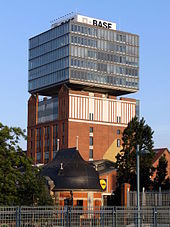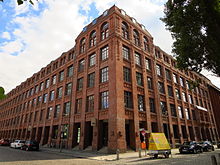Auergesellschaft
The Auergesellschaft was originally (at the end of the 19th century) a Berlin company for the manufacture of gas mantles and metal filament lamps . At the founding location in Berlin-Friedrichshain , successor companies continued to produce lamps until 1992 .
After 1920, the Auer company has a worldwide reputation as a manufacturer of compressed air - breathing apparatus purchased for fire departments and is now as MSA - The Safety Company to the American MSA Safety Corporation (Mine Safety Appliances). In addition to fire brigade and other protective equipment , gas warning devices and test tubes are also developed and produced at the Berlin site .
Carl Auer Freiherr von Welsbach

In 1885, the Austrian Carl Auer invented the incandescent mantle , also known as the Auerstrumpf , which made the gas lighting of the time much more efficient. By using thorium and cerium oxide , the incandescent gas light ( Auerlicht ) was superior to all light sources known at the time in terms of brightness and operating costs.
Auer also invented the metal filament lamp ( patented in 1898) and in 1906 registered the Osram trademark for “electric incandescent and arc light lamps ” at the Imperial Patent Office in Berlin.
founding
In 1892, the Deutsche Gasglühgesellschaft-Aktiengesellschaft (Degea, DGA), later Auergesellschaft, was founded in Berlin. The Auerlicht was introduced as street lighting in Berlin in 1895 , and in 1896 by the Prussian Railway Company . Subsidiaries were established from 1901 , initially in Austria, the USA and England.
Deutsche Gasglühlicht AG
The company, initially trading as Deutsche Gasglühlicht-Anstalt , initially had its production facility for rent from 1907 in the Industriepalast in Berlin, a multi-storey factory at Warschauer Strasse 34 to 44. Later, as Deutsche Gasglühlicht AG, it moved into its own factory complex on Rotherstrasse .
In the years 1906 to 1912 Gasglühlicht AG built the incandescent lamp factory, the most striking structure of which, the initially ten-story tower ("House 3"; Rotherstraße 11), was Berlin's first high-rise . The skyscraper and several large brick factory buildings of the complex later known as the Lamp City are based on designs by Theodor Kampffmeyer (1856–1913).
Orgacid GmbH in Ammendorf near Halle, operated jointly with Th. Goldschmidt AG from Essen and founded in 1934, produced mustard gas among other things until 1942 .
In 1963 the tower, which was now used by the GDR incandescent lamp combine NARVA , was given a glass lamp test room on the roof. The Narva Tower, rebuilt in 2000, is now a technical monument and serves as an office building. The building complex around the incandescent high-rise now officially bears the name Oberbaum City , named after the nearby Oberbaum Bridge or the Oberbaum on the Spree.
Deutsche Gasglühlicht AG spun off its light bulb business in November 1918 and founded OSRAM GmbH KG , in which the two other large German light bulb manufacturers, Siemens & Halske and AEG , participated in 1920 . The first financial year and the establishment of the company were set retrospectively to July 1, 1919. At that time, glassblowers were still employed in their own glassworks at the only company headquarters in Berlin . The glass flasks were later largely produced in Weißwasser / Oberlausitz .
In the time of National Socialism
After incandescent lamp production was outsourced to OSRAM, the production of luminous paints started in 1923 and a plant was built in Oranienburg in 1926 . After the National Socialists came to power in 1933, the Jewish shareholders Leopold Koppel and his son Albert Leopold Koppel were forced out of the company. After the company was converted into a stock corporation, it was affiliated to Degussa in 1934 . In 1935 the Auergesellschaft developed the fluorescent tube , in 1938 the Auer-Glaswerke was established . The Auerwerke enriched uranium oxide from South America under the leadership of their research director Nikolaus Riehl and were involved in Hitler's secret bomb plans ( uranium project ). After the production became known, the Allies bombed Oranienburg in a targeted manner in 1945. The explosive force of the bombs that destroyed the production facilities resulted in the release and distribution of the radioactive material. Since then, Oranienburg has been the most radioactive place in Germany. The Oranienburg plant was not rebuilt.
From 1940 until the general knowledge of the harmfulness of ionizing radiation after the atomic bombs were dropped on Hiroshima and Nagasaki (Japan, August 1945), the Auergesellschaft produced the radioactive toothpaste Doramad .
As part of the acquisition , Riehl had contact with Hans-Joachim Born , Alexander Catsch and Karl Zimmer, who were doing research under Nikolai Wladimirowitsch Timofejew-Ressowski at the Institute for Experimental Genetics of the Kaiser Wilhelm Society in Berlin-Buch . With Paul Max Wolf, an employee of the scientific laboratories of the Auergesellschaft, and Karl Günther Zimmer (1911–1988) research with X-ray irradiation in genetics was carried out. As a result, Timofejew-Ressowski, Max Delbrück , Zimmer and Riehl published the interdisciplinary study on the nature of gene mutation and gene structure in 1935 . In this study, the hit theory of biological radiation effects was postulated.
On October 1, 1938 , German troops occupied the Sudetenland and the Auergesellschaft was now exploiting uranium mines in Jáchymov . From 1939 to 1945 the Auergesellschaft was affiliated with the SS business enterprise "Seltene Erden" Oranienburg , which was headed by Egon Ihwe, and supplied the uranium project with uranium. Under the direction of Abraham Robert Esau , the uranium association had been working in Berlin since April 29, 1939 . Paul Harteck drew attention to the importance of nuclear fission in a letter dated April 24, 1939 to Erich Schumann , the head of the research department of the Heereswaffenamt (HWA), whereupon the uranium association was subordinated to the Heereswaffenamt.
On September 9, 1939, Riehl became head of uranium production at Auergesellschaft. Paul Max Wolf became head of the radiological department of the Auergesellschaft. Hans-Joachim Born from the Philipp Hoernes Chemical Laboratory was the factory manager of the rare earths plant of the Auergesellschaft in Oranienburg.
After the German occupation of France, the French company Joliot was confiscated for the Auergesellschaft. (The head of the company, Henry Joliot, had been a member of the Paris Commune in 1870/1871 . When he returned from Belgium after an amnesty , he opened a trade in rare earths from the Belgian Congo . His youngest son, the well-known physicist Frédéric Joliot-Curie, ordered 1939 six tons of uranium oxide in the Belgian Congo for the Curie Institute in Paris. Joliot was about Jacques Allier in February 1940. 185 kg heavy water from Norsk Hydro supply in Rjukan.) Under the supervision of Oswald Maier the stolen from the company Joliot metals were brought to the Auergesellschaft in Oranienburg. When the Americans learned from the Alsos mission in Strasbourg that the heavy metal oxides were being collected at a plant 15 miles north of Berlin, the plant was the target of an Allied air strike. On March 15, 1945, 612 Boeing B-17s of the 8th US Air Fleet dropped 1,506 tons of explosive and 178 tons of incendiary bombs on the Auergesellschaft plant in Oranienburg within 30 minutes, according to a plan by Carl A. Spaatz . In order to hide the target of the attack, the headquarters of OKH and OKW in Wünsdorf / Waldstadt near Zossen were attacked. In the compensation application of the Auergesellschaft from the beginning of April 1945, the damage at the Oranienburg plant, based on the balance sheet documents from June 1944, was estimated at 61 million Reichsmarks .
Further development

The Auergesellschaft, which was re-established in the western sectors of Berlin, developed gas measurement indicators and the first test tubes in 1955, and the catalytic gas sensor in 1959 . In 1958 the Auergesellschaft merged with the US company Mine Safety Appliances , as a result of which the Auergesellschaft was converted into a GmbH in 1960 . In 1961 the foundation stone was laid for the Trier plant .
In 1962, Robert F. Kennedy and Willy Brandt visited AUER GmbH in West Berlin as a sign of American solidarity with Berlin.
In 1973 the MSA Europe was founded in Berlin, in 1978 the Auergesellschaft relocated its headquarters to Berlin-Neukölln . In the following years, numerous systems for breathing apparatus were developed. From 2000 the Auergesellschaft operated as MSA AUER GmbH . This name was also used as a trademark between 2000 and 2009. Since October 2009, all MSA subsidiaries worldwide have been using the MSA - The Safety Company brand . The German subsidiary MSA AUER GmbH was split up in 2015. The legal successor is MSA Deutschland GmbH. In addition, at the location in Thiemannstr. in Berlin now MSA Produktion Deutschland GmbH, MSA Technologies and Enterprise Services GmbH and MSA Safety Services GmbH.
Movie
- Nazi uranium is a secret: bombing in Brandenburg. Documentary, Germany, 2013, 43:26 min., Script and direction: Thomas Claus and Maren Schibilsky, production: rbb , first broadcast: November 26, 2013 ibid.
Web links
- Detailed history of the Auer Society (PDF file; 263 kB)
- On the history of the district and the NARVA plant on Oberbaum
- Company website MSA - Berlin location
- Early documents and newspaper articles on the Auergesellschaft in the 20th Century press kit of the ZBW - Leibniz Information Center for Economics .
- RBB: The atomic bomb came from Germany (video; duration: 25:35)
Individual evidence
- ↑ Wolfgang Benz , Barbara Distel (ed.): The place of terror . History of the National Socialist Concentration Camps. Volume 3: Sachsenhausen, Buchenwald. CH Beck, Munich 2006, ISBN 3-406-52963-1 , p. 241.
- ↑ On the nature of gene mutation and gene structure. In: News from the Society of Science in Göttingen. (PDF file; 8.4 MB).
- ↑ Florian Schmaltz: Warfare agent research in National Socialism. For cooperation between Kaiser Wilhelm Institutes, the military and industry. History of the Kaiser Wilhelm Society during National Socialism. Wallstein, Göttingen 2005, ISBN 3-89244-423-4 , p. 252.
- ↑ As big as a pineapple ... In: Der Spiegel . No. 23 , 1967 ( online - May 29, 1967 ).
- ^ Obituary of Frédéric Joliot-Curie. ( Memento from May 29, 2013 in the Internet Archive ) In: Le Monde from August 15, 1958. (English)
- ↑ Hot grapefruit . In: Der Spiegel . No. 29 1993 ( online - 19 July 1993 ).



